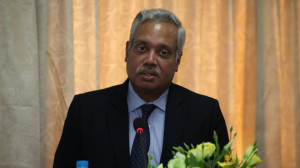National
Nepal’s queer community battles a silent drug crisis
A new study reveals a surge in sexualised drug use among transgender people and sex workers. But stigma keeps many from seeking treatment.
Aarati Ray
It began with what seemed like a harmless offer, a small pill that promised to help Sagar, a nervous 21-year-old on a date in Thamel, relax and enjoy himself. The man he had met at a bar was older and persuasive. “He said it would make sex better,” Sagar recalled, describing his first experience of chemsex (a slang term for sex under the influence of drugs) two years ago.
For Sagar (whom the Post is identifying with a pseudonym for his privacy), that night, everything felt heightened but blurry. He is not sure if they used a condom. He is not even sure he could have asked. “It felt thrilling at the time,” he says. “I didn’t realise the kind of danger I was exposing myself to back then.”
Sagar’s experience is not unique.
A study released last month by Nepali LGBTQIA+ advocacy group Blue Diamond Society (BDS) in collaboration with British pharma company ViiV Healthcare reveals a rise in sexualised drug use (SDU), often referred to as chemsex, among marginalised communities including men who have sex with men (MSM), transgender individuals (TG), male sex workers (MSW), and people who use drugs (PWUD).
But chemsex comes with serious risks including unprotected sex, sexual violence, non-consensual activity, addiction, and serious mental health issues.
The BDS study surveyed 393 MSM, TG, MSW and 402 PWUD participants across all seven provinces of Nepal.
Among MSM, TG, and MSW respondents, 36.12 percent reported using drugs like Viagra, ketamine, ecstasy, or tramadol to enhance sexual pleasure. More than 42 percent said they were coerced into condomless sex while under the influence.
Chemsex is not exclusive to Nepal. In Asia, its prevalence among men who have sex with men ranges from three percent to 31 percent, depending on the country. Though more common in the MSM community, people from all backgrounds engage in it.
For instance, among PWUD in Nepal, 72.97 percent used non-injectable drugs before sex, and 97.59 percent learnt the practice from friends. In case of PWUD, nearly 22 percent were pressured into condomless sex.
Over a half reported mental health struggles, yet many, like Sagar, avoided help out of fear or shame.
“I didn’t feel in control anymore,” says Sagar, whose casual use of viagra escalated to ecstasy and ketamine. “There were times I didn’t want to have sex, but I had already taken something [drugs] or he [his partner] had. Saying no felt pointless.”
The experiences took a toll on Sagar’s mental health as the lines of consent during sex started to blur, and he became addicted to drugs even outside of sex.
Suffering from depression and trauma induced by sex, he began withdrawing from friends, skipping HIV and STI checkups, afraid he would be judged.
For Kajal, a 27-year-old transgender woman from Janakpur, the loss of agency was even more violent. She met a man through a friend and began dating.
Within a week, he introduced drugs into their sex life. “I was scared when he proposed, but I agreed. People like me rarely get the chance to be in a relationship,” said Kajal, who the Post is identifying with a pseudonym. “I took the drugs, grateful, in a way, that someone was willing to be with me.”
In the months that followed, he repeatedly gave her pills before sex, sometimes without her consent. Other times, her partner would be high on drugs. The violence escalated.
“He’d slap me, force me into things I hadn’t agreed to… everything felt so violating,” she says. “But I told myself it must be the normal way of affection.”
Even in the report by BDS, the blurred line between affection, coercion, and chemical submission came up again and again. In total, 45 percent of participants reported experiencing violence during drug-fuelled sex, including physical, verbal, and sexual abuse.
Overdose is another serious risk. In fact, 69.01 percent of people in the study had overdosed on sexualised drugs.
“I have heard of many such instances of drug use in the community,” says Sanaya Bal, a sexual and reproductive health rights advocate. “Maybe it’s also affected by loneliness, stigma, and wanting to be wanted in this heteronormative world. Many got addicted to drugs and were hurt because of it.”
Among those reporting mental health problems related to SDU, nearly 77 percent did not seek help. Reasons included fear of exposure and discrimination, and internalised stigma.
Kajal, like many others, avoided hospitals altogether. In the past, at Janakpur Provincial Hospital, she had faced discrimination and degrading remarks like “transgender people are prostitutes” and was mocked for her identity.
So, even when the violent sexual experiences began to cause complications with her health, she stayed away.
“These are not stories of bad decisions,” says Manisha Dhakal, executive director of the Blue Diamond Society. “They are stories of structural failure, of a system that still doesn’t see trans women, MSM, and sex workers as people who deserve care.”
Dhakal says the rise in chemsex and SDU must be seen as a public health issue, not a private shame. “We need to integrate SDU-related care into HIV services. That means PrEP [a medication that reduces the risk of contracting HIV], mental health, Hepatitis C treatment, all of it,” she says.
Stigma in healthcare settings remains a major barrier for the queer community.
While HIV testing rates among MSM, TG and MSW are relatively high (92.96 percent), consistent use of PrEP and Hepatitis C screening lags behind. Only 70.42 percent had been tested for Hepatitis C, and mental health care remains inaccessible for many.
“In our case, there’s neither enough education about sexual and reproductive health in textbooks nor respectful treatment from hospitals and healthcare workers,” says Kajal. “So for me, even abuse during sex felt normal… I had no other option.”
In response to the findings, the study recommends several key actions. It calls for the creation and distribution of easy-to-understand educational materials that promote safer sex, raise awareness about health risks, guide overdose response, and encourage people to seek help. Second, it urges better access to harm reduction tools like condoms, lubricants, clean needles, and overdose-reversing medicines.
“We need inclusive healthcare, an empathetic and safe space where we can get non-judgmental healthcare,” says Sagar. “For that, healthcare providers should be trained and the government should create guidelines to stop the stigma and discrimination”.
Dhakal seconds that. She says the government should focus on accessible mental health services, including mobile outreach and referral systems, to address the psychological impacts of sexualised drug use. “We need evidence-based policy changes and long-term funding support from the government to sustain harm reduction efforts.”




 19.12°C Kathmandu
19.12°C Kathmandu















